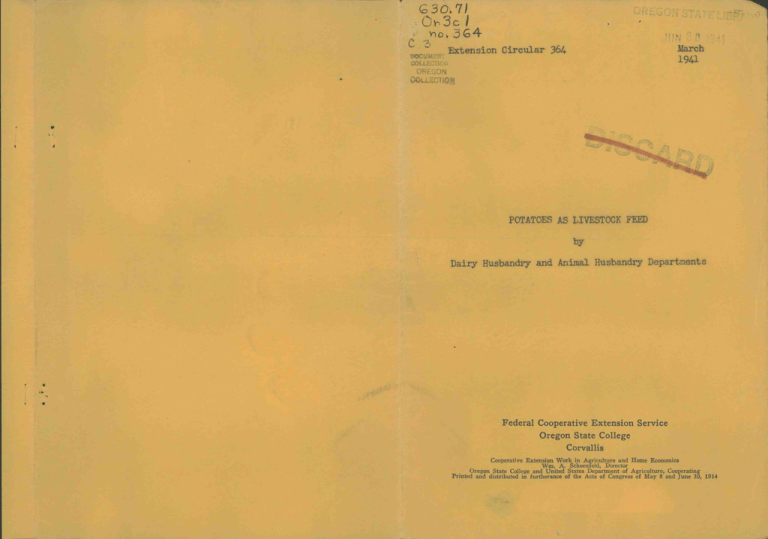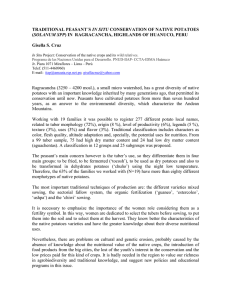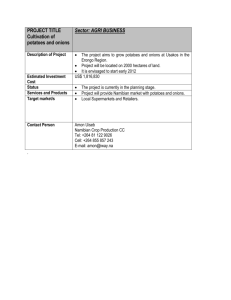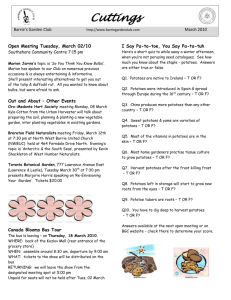'o,G4 G3c7) .(p3cI Federal Cooperative Extension Service
advertisement

G3c7) .(p3cI 'o,G4 1arch Extension Circular 364 1941 p POTATOES AS LIVESTOCK FEEl) by Dairy Husbandry and Animal Husbandry Departments S Federal Cooperative Extension Service Oregon State College Corvallis Cooperative Extension Work in Agriculture and Home Economics Wm. A. Schoenfeld, Director Oregon State College and United States Department of Agriculture, Cooperating Printed and distributed in furtherance of the Acts of Congress of May 8 and June 30, 1914 OR4Ori STATt L!PARY 3o.'7I O3c! )o, .%4 March cterision Circular 364 1943. OREGUi' POTATOES AS LIVESTOCK FEED Dairy Husbandry and Anbnal Husbandry Departments Many thousands of tons of cull potatoes are available each year for livestock feed. In years of large yields potato prices are low and a considerable tonnage of surplus potatoes ol the lower grades is available to livestock feeders. In Germany and some other countries heavy-yielding varieties of large potatoes In normal times 40 per cent of the potato crop are growi for £eodiig purposes. grown in Germany is Led to farm animals in cnpxison with only 5 per cent in the United States. Feeders in this country evidently are not so generally acquainted with the value of potatoes in comparison with other feeds. Digestible Nutrient Value. The dry matter, digestible crude protein, total digestible nutrients, calcium, and phosphorus content of potatoes and some other feeds are compared below: Feed Potatoes Corn silage Carrots Sugar beets Green corn Green alfalfa Pasture grass and clover Alfalfa hay* Ryegrass hay Barle,* Dry Matter Per cent 21.2 28.3 11.9 16.4 24.0 25.4 Digestible Crude Protein Per cent Total Digestible Nutrients Per cent 1.1 1.3 0,8 1.2 1.2 3.4 17.3 18.7 9.6 13.8 16.3 14.7 26 Calcium Per cent 0.01 0.07 0.06 0.03 0.06 0.40 Phosphorus Per cent 0.05 0.06 0.06 0.04 0.05 0.06 0.19 0.24 16,1 0.20 1.27 49,7 9.2 0.20 0.30 3.6 44.7 0.36 0.05 78.8 7,5 1.00 0.10 69.7 12.9 900 Milirun 0.02 0.05 58.8 2.5 80.6 Beet molasses * Oregon analyses. AU othei' analyses taken by special, permission of The Morrison Publishing Company, Ithaca, N.Y., front "Feeds and Feeding," 20th ed. F. B. Morrison, 24.4 90.0 87.4 90.0 2 It will be noted that potatoes are quite similar in feeding value to average corn silage. Being low in dry matter, most of which is starch, they are classed as a succulent feed and like all the root crops are low in protein content. However, they are 50 per cent to 100 per cent higher in total digestible nutrient value than other root crops such as mangels, comton beets, turnips and rutabagas. Potatoes contain only onefourth to onethird as much digestible protein as pasture grasses and clovers and green legimies but have about the sante total digestible nutrient value. In comparison with alfalfa hay, potatoes contain about onethird as much total digestible nutrients and oneninth as much digestible protein. Potatoes are worth then approximately onethird as much per ton as alfaJ.fa hay. Another way to cnparo the value of potatoes with alfalfa hay is to figure that the price of potatoes per bushel in cents should be the same as the price of alfalfa For example, if alfalfa hay is selling at $12.00 per hay per ton in dollars ton, potatoes are then worth 12 cents a bushel for dairy cattle feed. At 60 pounds per bushel this is equivalent to 34.00 per ton for potatoes or onethird the price of alfalfa as above stated. It will be noted fran the tab.e that potatoes are very low in calcium but have about the same amount of phosphorus as other feeds of similar dry matter content. Potatoes do not contain appreciable amounts of vitamins A or D. Feeding Dairy attle Potatoes have been fed to dairy cattle in recent feeding Feeding Trials. In both cases trials at the North Dakota and Idaho Experiment Stations The results of the feeding trials show potatoes were compared to corn silage that raw potatoes were aantost equal to corn silage for milk production when fed at the rate of 20 to 35 pounds daily along with a hay and grain ration. Potatoes are not as palatable as corn silage but if the amount offered is entail at first cows will eat gradually increasing amounts. In the Idaho trials 30 pounds of potatoes were fed daily to Hoisteins and 25 pounds to Jerseys. Some Holsteins ate as much as 40 pounds. On the basis of' 1000 pounds of live weight the average consumption was 23 pounds. Potatoes did not cause cows to go off feed. Individual cows differ in the amount of potatoes they can eat. Potatoes are more laxative than corn silage and it is important that the manure of the individual animals be watched and the amount fed be regulated thereby. If the manure becomes thin the amount of potatoes fed should be reduced to prevent scours or bloat. In another Idaho feedingtrial cooked Raw Potatoes Best for Cattle. potatoes were compared to raw potatoes f' dairy cattle. In so far as milk and butterfat production was concerned there was no dilTerence between the raw and cooked potatoes. However, when the cooked potatoes were fed, digestible trouble such as scours or bloat was quite camion. No digestive disturbances resulted after the cows became accustomed to raw potatoes. * North Dakota Bul. 245; Idaho Bul. 216. 3 Effect on Dairy Products. There is a common belief that potatoes cause sit off-flavor in milk and salviness in butter, The experiments at North Dakota The milk produced when potatoes were fed and Idaho do not show this to be true had good average flavor equal to that when corn silage was fed. Butter made from milk produced by the potato-fed cows had noial body and texture with no evidence f salviness or potato flavor. on Feeding, Potatoes should be run through a root cutter, or crushed before feeding to prevent cows from choldng. and potato sprouts contain a considerable amount o± solanin, Potatoes that have been and should not be fed to livestock. Partly decomposed potatoes should frozen may be thawed out arid fed i.nuuediately. Since potatoes have a ]aacive effect they not be fed in large quantities. should be fed with non-laxative feeds. Plenty of hay and some concentrates tend to keep down digestive disturbances. For good producing dairy cows fed 25 to 30 pounds of potatoes daily a legume hay and a concentrate mixture containing about 16 per cent crude protein is desirable. Precautions cut with a shove], Sunburned potatoes which is poisonous _eding Hogs Cooked Potatoes Best for Hogs. Potatoes should be cooked before being fed to hogs as it greatly increases their feeding value arid palatability. Four hundred twenty-five pounds of cooked potatoes are required to replace 100 pounds of barley, corn or wheat, when fed at the rate o± four pounds to one pound of It requires 600 pounds of raw potatoes to replace 100 pounds of grain grain. as compared to 425 pounds of cooked potatoes, or a saving oi' 30 per cent. Owing to increased palatability, pigs can be induced to consume enough cooked potatoes to make proper gains or growth without the use of an excessive amount of grain. Potatoes should be cooked until they are mealy and the skins burst. Cooking potatoes as for table use is not ci ficient for hogs. No more water should be used in cooking than is absolutely necessary. Adding water increases the amount of water the pigs have to consume, which will in turn decrease the amount of potatoes they can consume and thereby decrease the gains. Potatoes can be cooked in a barrel with steen by running a steam hose to the bottom of the Another convenient way is barrel and covering the barrel with gunny sacks to cook them in the scalding vat by adding about two inches of water in the bottom of the vat and covering the potatoes with gunny sacks to keep in the steam, The water the potatoes were cooked in should be poured off as it is bitter and unpalatable. Potatoes Require Grain Supplement. As indicated above, cooked potatoes give the best results when fed at the rate of four pounds of potatoes to one pound of grain. Nhere a farmer has a very large amount ol' potatoes and a limited amount of grain, he can feed more potatoes than four to one but the feeding value of the potatoes will be decreased and the daily gains will be less. Pigs will not get fat on potatoes alone. Cooked potatoes can be fed to all classes of hogs but the proportion of grain to potatoes should be varied to suit their needs. It is not advisable to compel weanling pigs to consume more than two pounds of potatoes to one of grain. For fattening pigs the best proportion is four pounds of potatoes to one pound. of grain. For the breeding herd a higher proportion of potatoes may * 4 be used, that is, about six pounds potatoes to one pound of grain. WeanJ.ing pigs or fattening pigs should be Led all they will consume but for the breeding Barley, herd only enough should be used to keep them in good breeding condition. corn or vtheat are best suited to feed with potatoes for fattening pigs, while oats are suitable for the breeding herd. Uncooked Grain is Best. Do not cook grain with potatoes as cooking The grain cai be mixed with the potatoes grain decreases its feeding value. after they are cooked or, prefertb1y, spread on top of the potatoes in the trough. Bulky feeds ouch as bran, miliruri, etc., should not be fed with potatoes. 3kim milk or buttermilk can be ied vrit: potatoes, but such Leeds replace the Dotatoes of the ration rather than the gran. Care should be taken that the potatoes are not allowed to sour before feeding. Fattening pigs need se protein to balance the ration of grain arid Hall' a pound of taxikage potatoes, also they need saite alfalfa meal for vitamins or fishmeal daily, per pig, is sufficient and about 1/4 pound alialfa meal will balance the ration. Feeding BeeL pattle and Sheep Potatoes used as a feed for either beef cattle or sheep should be Led in the sane general way as corn silage. Cattle or sheep should be started gradually on potatoes, which are not very palatable. The feeding of large amounts of raw potatoes generally causes scours. The manure should be watched and the quantity of potatoes adjusted accordingly. In cattle feeding, potatoes can be fed at the Fattening rate of 20 to 40 pounds per head, depending on the size of the cattle. steers weighing about 1000 pounds best utilize potatoes when fed at the rate of 20 to 25 pounds per head along with grain and hay. Mature beef cattle can be wintered on 30 to 40 pounds of potatoes fed with all the legume hay or mixed hay they will consume. Sheep make the best use of potatoes when fed with legume hay at the rate of 1 to 2 pounds per head. Various experiments with feeding potatoes to beef cattle and sheep show that they have about 80% of the feeding value of corn silage when fed in limited amounts and used as a substitute for grain or other Leeds in the ration. Inasmuch as potatoes are a succulent feed low in protein and in vitamins A and D, a well-cured legume hay or good mixed hay should be fed with them. For fattening purposes it is necessary to feed. grain as a part of the ration. When cull potatoes and small potatoes are fed, to cattle or sheep it is usually a good practice to slice or chop the potatoes in order to make them It is not profitable to cook potatoes for more palatable arid to avoid choking. beef cattle or sheep.



